Atlantis retired
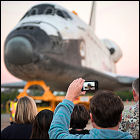 Stripped of critical working systems and engines after her final landing, Space Shuttle Atlantis is moved via a ground transport to a new shuttle museum exhibit at the Kennedy Space Center Visitors’ Center at Cape Canaveral. Having flown 33 times, Atlantis was the last shuttle to travel in space, having returned from orbit the final time in July 2011. Originally intended to be the last addition to the shuttle fleet, construction on Atlantis began in 1980, and was completed in time for Atlantis’ maiden voyage in 1985.
Stripped of critical working systems and engines after her final landing, Space Shuttle Atlantis is moved via a ground transport to a new shuttle museum exhibit at the Kennedy Space Center Visitors’ Center at Cape Canaveral. Having flown 33 times, Atlantis was the last shuttle to travel in space, having returned from orbit the final time in July 2011. Originally intended to be the last addition to the shuttle fleet, construction on Atlantis began in 1980, and was completed in time for Atlantis’ maiden voyage in 1985.
STS-135: final flight of the Space Shuttle
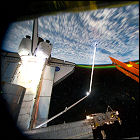 Space Shuttle Atlantis lifts off on the 135th and final flight of an American Space Shuttle. During the 13-day mission to the International Space Station, the final shuttle-sized supply delivery takes place. The mission was originally budgeted as a rescue flight for the final Hubble Space Telescope servicing flight in 2009, but is approved as a final station flight since funding and supplies had already been set aside. Atlantis’ 33rd and final crew is Commander Chris Ferguson, Pilot Doug Hurley, and mission specialists Rex Walheim and Sandy Magnus. Upon landing at Kennedy Space Center for the final time, Atlantis joins the other orbiters in a months-long process to strip them of working engines and other key components before the shuttles are delivered to their museum destinations.
Space Shuttle Atlantis lifts off on the 135th and final flight of an American Space Shuttle. During the 13-day mission to the International Space Station, the final shuttle-sized supply delivery takes place. The mission was originally budgeted as a rescue flight for the final Hubble Space Telescope servicing flight in 2009, but is approved as a final station flight since funding and supplies had already been set aside. Atlantis’ 33rd and final crew is Commander Chris Ferguson, Pilot Doug Hurley, and mission specialists Rex Walheim and Sandy Magnus. Upon landing at Kennedy Space Center for the final time, Atlantis joins the other orbiters in a months-long process to strip them of working engines and other key components before the shuttles are delivered to their museum destinations.
Retirement homes for Space Shuttles
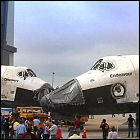 NASA announces the results of a bidding process for soon-to-be-retired Space Shuttle vehicles by institutions across the country. The original test vehicle, Enterprise, will be removed from the Smithsonian and replaced by the space-flown Discovery, while Atlantis will become the centerpiece of a new exhibit at NASA’s own Kennedy Space Center. Endeavour will be handed over to the California Science Museum in Los Angeles, while Enterprise’s new home will be in New York City’s Intrepid Museum. Institutions not selected to receive one of the shuttles, including NASA’s Johnson Space Center in Houston, Texas, almost immediately claim that the selection process has been swayed by politics. None of the vehicles will be transported from Kennedy Space Center to their new locations until the following year.
NASA announces the results of a bidding process for soon-to-be-retired Space Shuttle vehicles by institutions across the country. The original test vehicle, Enterprise, will be removed from the Smithsonian and replaced by the space-flown Discovery, while Atlantis will become the centerpiece of a new exhibit at NASA’s own Kennedy Space Center. Endeavour will be handed over to the California Science Museum in Los Angeles, while Enterprise’s new home will be in New York City’s Intrepid Museum. Institutions not selected to receive one of the shuttles, including NASA’s Johnson Space Center in Houston, Texas, almost immediately claim that the selection process has been swayed by politics. None of the vehicles will be transported from Kennedy Space Center to their new locations until the following year.
STS-132
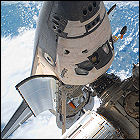 Space Shuttle Atlantis lifts off on the 132nd shuttle flight, a 12-day resupply and maintenance mission to the International Space Station. A “mini research module” built by the Russian space agency is attached to the station, along with cargo and supplies. Upgrades to the station’s solar power arrays are conducted during spacewalks. Aboard Atlantis for her last planned flight (an additional mission will later be scheduled for Atlantis in 2011) are Commander Ken Ham, Pilot Tony Antonelli, and mission specialists Garrett Reisman, Michael Good, Piers Sellers and Steve Bowen. This is the last shuttle flight for over six months.
Space Shuttle Atlantis lifts off on the 132nd shuttle flight, a 12-day resupply and maintenance mission to the International Space Station. A “mini research module” built by the Russian space agency is attached to the station, along with cargo and supplies. Upgrades to the station’s solar power arrays are conducted during spacewalks. Aboard Atlantis for her last planned flight (an additional mission will later be scheduled for Atlantis in 2011) are Commander Ken Ham, Pilot Tony Antonelli, and mission specialists Garrett Reisman, Michael Good, Piers Sellers and Steve Bowen. This is the last shuttle flight for over six months.
STS-129
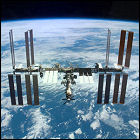 Space Shuttle Atlantis lifts off on the 129th shuttle flight, an 11-day mission to the International Space Station. Equipment, supplies, and spare parts are delivered, enough to make in-orbit maintenance of the station possible for several years. Aboard Atlantis for her 31st flight are Commander Charles Hobaugh, Pilot Barry Wilmore, and mission specialists Mike Foreman, Leland Melvin, Robert Satcher and Randy Bresnik; ISS crewmember Nicole Stott returns to Earth via Atlantis, and is the last ISS crewmember to return home on a shuttle.
Space Shuttle Atlantis lifts off on the 129th shuttle flight, an 11-day mission to the International Space Station. Equipment, supplies, and spare parts are delivered, enough to make in-orbit maintenance of the station possible for several years. Aboard Atlantis for her 31st flight are Commander Charles Hobaugh, Pilot Barry Wilmore, and mission specialists Mike Foreman, Leland Melvin, Robert Satcher and Randy Bresnik; ISS crewmember Nicole Stott returns to Earth via Atlantis, and is the last ISS crewmember to return home on a shuttle.
STS-125: last stop at Hubble
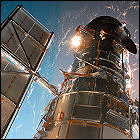 Space Shuttle Atlantis lifts off on the 126th shtutle flight, the final servicing mission to the Hubble Space Telescope (and the only post-Columbia flight not to visit the International Space Station). The repairs and upgrades conducted during a series of spacewalks will extend Hubble’s operation life through at least 2014. Aboard Atlantis for her 30th flight are Commander Scott Altman, Pilot Greg Johnson, and mission specialists John Grunsfeld, Michael Massimino, Andrew Feustel, Michael Good and Megan McArthur. This mission was nearly cancelled in light of post-Columbia flight rules requiring all shuttle flights to visit the space station.
Space Shuttle Atlantis lifts off on the 126th shtutle flight, the final servicing mission to the Hubble Space Telescope (and the only post-Columbia flight not to visit the International Space Station). The repairs and upgrades conducted during a series of spacewalks will extend Hubble’s operation life through at least 2014. Aboard Atlantis for her 30th flight are Commander Scott Altman, Pilot Greg Johnson, and mission specialists John Grunsfeld, Michael Massimino, Andrew Feustel, Michael Good and Megan McArthur. This mission was nearly cancelled in light of post-Columbia flight rules requiring all shuttle flights to visit the space station.
STS-122
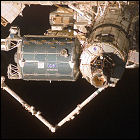 Space Shuttle Atlantis lifts off on the 121st shuttle flight, a 13-day mission to deliver another laboratory module to the International Space Station. The European Space Agency’s Columbus lab module is ESA’s contribution to the station, and is attached to the recently-installed Harmony node over the course of three spacewalks. Aboard Atlantis for her 29th flight are Commander Steve Frick, Pilot Alan Poindexter, and mission specialists Stanley Love, Leland Melvin, Rex Walheim and Hans Schlegel. ISS Expedition 17 crewmember Leopold Eyharts travels to the station aboard Atlantis, while ISS Expedition 16 crewmember Daniel Tani returns to Earth on the shuttle in his place.
Space Shuttle Atlantis lifts off on the 121st shuttle flight, a 13-day mission to deliver another laboratory module to the International Space Station. The European Space Agency’s Columbus lab module is ESA’s contribution to the station, and is attached to the recently-installed Harmony node over the course of three spacewalks. Aboard Atlantis for her 29th flight are Commander Steve Frick, Pilot Alan Poindexter, and mission specialists Stanley Love, Leland Melvin, Rex Walheim and Hans Schlegel. ISS Expedition 17 crewmember Leopold Eyharts travels to the station aboard Atlantis, while ISS Expedition 16 crewmember Daniel Tani returns to Earth on the shuttle in his place.
STS-117
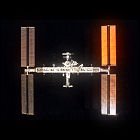 Space Shuttle Atlantis lifts off the 118th shuttle flight, on a two-week mission to resupply and continue assembly of the International Space Station. Two major structural trusses and two large solar power arrays are delivered and installed, and a damaged array is removed. Aboard Atlantis for her 28th flight are Commander Rick Sturckow, Pilot Lee Archambault, and mission specialists Patrick Forrester, Danny Olivas, Clayton Anderson, Jim Reilly and Steven Swanson. Anderson remains on the station, joining the crew of ISS Expedition 15.
Space Shuttle Atlantis lifts off the 118th shuttle flight, on a two-week mission to resupply and continue assembly of the International Space Station. Two major structural trusses and two large solar power arrays are delivered and installed, and a damaged array is removed. Aboard Atlantis for her 28th flight are Commander Rick Sturckow, Pilot Lee Archambault, and mission specialists Patrick Forrester, Danny Olivas, Clayton Anderson, Jim Reilly and Steven Swanson. Anderson remains on the station, joining the crew of ISS Expedition 15.
STS-115
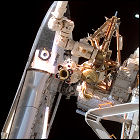 Space Shuttle Atlantis lifts off for its first spaceflight, and the first normal International Space Station construction mission, in four years. A new truss section with more 240-foot solar power panels is added to the station over the course of three spacewalks, each lasting at least six hours. Aboard Atlantis for this flight are Commander Brent Jett, Pilot Christopher Ferguson, and mission specialists Heidemarie Stefanyshyn-Piper, Joe Tanner, Daniel Burbank, and Steven MacLean.
Space Shuttle Atlantis lifts off for its first spaceflight, and the first normal International Space Station construction mission, in four years. A new truss section with more 240-foot solar power panels is added to the station over the course of three spacewalks, each lasting at least six hours. Aboard Atlantis for this flight are Commander Brent Jett, Pilot Christopher Ferguson, and mission specialists Heidemarie Stefanyshyn-Piper, Joe Tanner, Daniel Burbank, and Steven MacLean.
STS-112
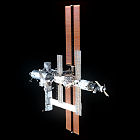 Space Shuttle Atlantis lifts off on the 111th shuttle flight, an 11-day construction mission to the International Space Station. Another major structural truss is assembled and attached, serving the primary function of radiating built-up waste heat away from the station and into space. Aboard Atlantis for her 26th flight are Commander Jeff Ashby, Pilot Pamela Melroy, and mission specialists David Wolf, Piers Sellers, Sandra Magnus and Fyodor Yurchikhin.
Space Shuttle Atlantis lifts off on the 111th shuttle flight, an 11-day construction mission to the International Space Station. Another major structural truss is assembled and attached, serving the primary function of radiating built-up waste heat away from the station and into space. Aboard Atlantis for her 26th flight are Commander Jeff Ashby, Pilot Pamela Melroy, and mission specialists David Wolf, Piers Sellers, Sandra Magnus and Fyodor Yurchikhin.
STS-110: giving ISS its backbone
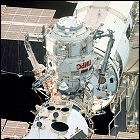 Space Shuttle Atlantis lifts off on the 109th shuttle flight, an 11-day mission to add the integrated truss “backbone” to the International Space Station. In addition to assembling and attaching this major part of the station, a mobile transport is added for the station’s remote manipulator arm, allowing the arm to roll from one end of the station to the other for whatever functions may be required. Aboard Atlantis for her 25th flight are Commander Michael Bloomfield, Pilot Stephen Frick, and mission specialists Jerry Ross, Steven Smith, Ellen Ochoa, Lee Morin and Rex Walheim.
Space Shuttle Atlantis lifts off on the 109th shuttle flight, an 11-day mission to add the integrated truss “backbone” to the International Space Station. In addition to assembling and attaching this major part of the station, a mobile transport is added for the station’s remote manipulator arm, allowing the arm to roll from one end of the station to the other for whatever functions may be required. Aboard Atlantis for her 25th flight are Commander Michael Bloomfield, Pilot Stephen Frick, and mission specialists Jerry Ross, Steven Smith, Ellen Ochoa, Lee Morin and Rex Walheim.
STS-104
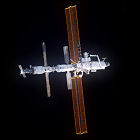 Space Shuttle Atlantis lifts off on the 105th shuttle flight, a 13-day flight to resupply and install new hardware on the International Space Station. The station gains a new airlock and an equipment pallet – formerly part of the Spacelab module – which is attached to the station’s exterior. Aboard Atlantis for her 24th flight are Commander Steven Lindsey, Pilot Charles Hobaugh, and mission specialists Michael Gernhardt, James Reilly and Janet Kavandi.
Space Shuttle Atlantis lifts off on the 105th shuttle flight, a 13-day flight to resupply and install new hardware on the International Space Station. The station gains a new airlock and an equipment pallet – formerly part of the Spacelab module – which is attached to the station’s exterior. Aboard Atlantis for her 24th flight are Commander Steven Lindsey, Pilot Charles Hobaugh, and mission specialists Michael Gernhardt, James Reilly and Janet Kavandi.
STS-98: fulfilling Destiny
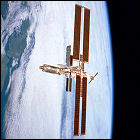 Space Shuttle Atlantis lifts off on the 102nd shuttle flight, a mission to install the American-made Destiny laboratory module on the International Space Station. Once attached to its connection point on the Unity module, Destiny is powered up and pressurized, adding more space for scientific experiments to the station. Aboard Atlantis for her 22nd flight are Commander Kenneth Cockrell, Pilot Mark Polansky, and mission specialists Robert Curbeam, Thomas Jones and Marsha Ivins.
Space Shuttle Atlantis lifts off on the 102nd shuttle flight, a mission to install the American-made Destiny laboratory module on the International Space Station. Once attached to its connection point on the Unity module, Destiny is powered up and pressurized, adding more space for scientific experiments to the station. Aboard Atlantis for her 22nd flight are Commander Kenneth Cockrell, Pilot Mark Polansky, and mission specialists Robert Curbeam, Thomas Jones and Marsha Ivins.
STS-106: getting the place ready
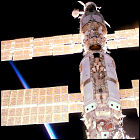 Space Shuttle Atlantis lifts off on the 99th shuttle mission, a 12-day visit to the still-unoccupied International Space Station. Spacewalks and work in the station’s pressurized compartments make the final connections between the Russian-launched Zvezda service module and the rest of the station, and over three tons of supplies – most flown aboard Atlantis, but some contained in an unmanned Progress supply ship which has already automatically docked to the station – are transferred to the station. Atlantis’ 21st crew is Commander Terrence Wilcutt, Pilot Scott Altman, and mission specialists Daniel Burbank, Edward Lu, Richard Mastracchio, Yuri Malenchenko and Boris Morokov. In 2003, Lu and Malenchenko will return as the station’s seventh full-time residents.
Space Shuttle Atlantis lifts off on the 99th shuttle mission, a 12-day visit to the still-unoccupied International Space Station. Spacewalks and work in the station’s pressurized compartments make the final connections between the Russian-launched Zvezda service module and the rest of the station, and over three tons of supplies – most flown aboard Atlantis, but some contained in an unmanned Progress supply ship which has already automatically docked to the station – are transferred to the station. Atlantis’ 21st crew is Commander Terrence Wilcutt, Pilot Scott Altman, and mission specialists Daniel Burbank, Edward Lu, Richard Mastracchio, Yuri Malenchenko and Boris Morokov. In 2003, Lu and Malenchenko will return as the station’s seventh full-time residents.
STS-101
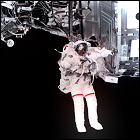 Carrying over 3,000 pounds of supplies for future station crews, Space Shuttle Atlantis lifts off on a ten-day mission to the International Space Station. The supplies include exercise equipment and general housekeeping gear; Atlantis boosts the still-under-construction vacant station’s orbit by 27 miles. Aboard Atlantis for her 20th flight are Commander James Halsell, Pilot Scott “Doc” Horowitz, and mission specialists Mary Ellen Weber, Jeff Williams, James Voss, Susan Helms and Yury Usachev.
Carrying over 3,000 pounds of supplies for future station crews, Space Shuttle Atlantis lifts off on a ten-day mission to the International Space Station. The supplies include exercise equipment and general housekeeping gear; Atlantis boosts the still-under-construction vacant station’s orbit by 27 miles. Aboard Atlantis for her 20th flight are Commander James Halsell, Pilot Scott “Doc” Horowitz, and mission specialists Mary Ellen Weber, Jeff Williams, James Voss, Susan Helms and Yury Usachev.
STS-86: seventh Shuttle-Mir docking
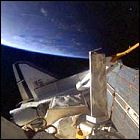 Space Shuttle Atlantis lifts off on an 11-day mission to dock with the Mir space station. In addition to routine supplies, replacement parts are brought to Mir to swap out with equipment damaged during the various incidents and accidents endured by Mir Expedition 23. The first-ever joint American/Russian spacewalk is conducted to undertake some of the repair activity and to try to find the location of the Spektr module hull breach. Aboard Atlantis for her 19th flight are Commander James Wetherbee, Pilot Michael Bloomfield, and mission specialists Vladimar Titov, Scott Parazynski, Jean-Loup Chretien, Wendy Lawrence and David Wolf. Wolf remains on Mir to join the Expedition 24 crew, while Mir crewmember Michael Foale returns to Earth aboard Atlantis, having served 145 unusually eventful days in space.
Space Shuttle Atlantis lifts off on an 11-day mission to dock with the Mir space station. In addition to routine supplies, replacement parts are brought to Mir to swap out with equipment damaged during the various incidents and accidents endured by Mir Expedition 23. The first-ever joint American/Russian spacewalk is conducted to undertake some of the repair activity and to try to find the location of the Spektr module hull breach. Aboard Atlantis for her 19th flight are Commander James Wetherbee, Pilot Michael Bloomfield, and mission specialists Vladimar Titov, Scott Parazynski, Jean-Loup Chretien, Wendy Lawrence and David Wolf. Wolf remains on Mir to join the Expedition 24 crew, while Mir crewmember Michael Foale returns to Earth aboard Atlantis, having served 145 unusually eventful days in space.
STS-84: sixth Shuttle-Mir docking
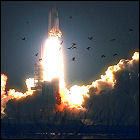 Space Shuttle Atlantis lifts off on the 84th shuttle mission, a ten-day flight with a visit to the Mir space station. Among the supplies hauled to Mir by Atlantis is a new oxygen generator to replace one damaged by a fire aboard the station in February. The crew for Atlantis’ 18th flight is Commander Charles Precourt, Pilot Eileen Collins, mission specialists Michael Foale, Carlos Noriega, Edward Lu, Jean-Francois Clervoy and cosmonaut Elena Kondakova. Foale remains to take up residence on Mir, while American astronaut Jerry Linenger leaves the station to return with the shuttle crew, having spent 132 days in space.
Space Shuttle Atlantis lifts off on the 84th shuttle mission, a ten-day flight with a visit to the Mir space station. Among the supplies hauled to Mir by Atlantis is a new oxygen generator to replace one damaged by a fire aboard the station in February. The crew for Atlantis’ 18th flight is Commander Charles Precourt, Pilot Eileen Collins, mission specialists Michael Foale, Carlos Noriega, Edward Lu, Jean-Francois Clervoy and cosmonaut Elena Kondakova. Foale remains to take up residence on Mir, while American astronaut Jerry Linenger leaves the station to return with the shuttle crew, having spent 132 days in space.
STS-81
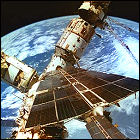 Space Shuttle Atlantis lifts off on the 81st shuttle flight, a ten-day mission featuring the fifth docking between Atlantis and the Mir space station. Atlantis again carries the SPACEHAB module in its cargo bay, and thousands of pounds of consumables and equipment are transferred from the shuttle to Mir. Aboard Atlantis for her 17th flight are Commander Michael Baker, Pilot Brent Jett, and mission specialists John Grunsfeld, Marsha Ivins, Peter Wisoff and Jerry Linenger. Linenger remains on Mir, while American Mir Expedition 22 crewmember John Blaha returns after 128 days in space.
Space Shuttle Atlantis lifts off on the 81st shuttle flight, a ten-day mission featuring the fifth docking between Atlantis and the Mir space station. Atlantis again carries the SPACEHAB module in its cargo bay, and thousands of pounds of consumables and equipment are transferred from the shuttle to Mir. Aboard Atlantis for her 17th flight are Commander Michael Baker, Pilot Brent Jett, and mission specialists John Grunsfeld, Marsha Ivins, Peter Wisoff and Jerry Linenger. Linenger remains on Mir, while American Mir Expedition 22 crewmember John Blaha returns after 128 days in space.
STS-79: fourth Shuttle-Mir mission
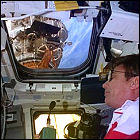 After multiple delays, including the entire launch stack having to be rolled back into the safety of the Vehicle Assembly Building to protect it from two back-to-back hurricanes, Space Shuttle Atlantis lifts off on the fourth mission to dock with the Russian Mir space station. Supplies are transferred to Mir, and numerous completed science experiments from Mir are loaded into the shuttle. Atlantis is flown by Commander William Readdy, Pilot Terrence Wilcutt, and mission specialists Thomas Akers, John Blaha, Jay Apt and Carl Walz. Blaha remains on Mir, taking the place of American astronaut Shannon Lucid, who has just set a new American space endurance record of 188 days in orbit; Lucid returns to Earth with the Atlantis crew.
After multiple delays, including the entire launch stack having to be rolled back into the safety of the Vehicle Assembly Building to protect it from two back-to-back hurricanes, Space Shuttle Atlantis lifts off on the fourth mission to dock with the Russian Mir space station. Supplies are transferred to Mir, and numerous completed science experiments from Mir are loaded into the shuttle. Atlantis is flown by Commander William Readdy, Pilot Terrence Wilcutt, and mission specialists Thomas Akers, John Blaha, Jay Apt and Carl Walz. Blaha remains on Mir, taking the place of American astronaut Shannon Lucid, who has just set a new American space endurance record of 188 days in orbit; Lucid returns to Earth with the Atlantis crew.
STS-76: third Shuttle-Mir docking
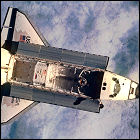 Space Shuttle Atlantis lifts off on the 76th shuttle mission, a flight to dock with the Russian space station Mir. Supplies are delivered to Mir by the Atlantis crew, and astronaut Shannon Lucid remains aboard Mir to join its Expedition 21 crew. Atlantis also carries the SPACEHAB module, where both the shuttle and station crews conduct joint scientific experiments. Aboard Atlantis for her 16th flight are Commander Kevin Chilton, Pilot Richard Searfoss, and mission specialists Shannon Lucid, Linda Godwin, Michael Clifford and Ronald Sega.
Space Shuttle Atlantis lifts off on the 76th shuttle mission, a flight to dock with the Russian space station Mir. Supplies are delivered to Mir by the Atlantis crew, and astronaut Shannon Lucid remains aboard Mir to join its Expedition 21 crew. Atlantis also carries the SPACEHAB module, where both the shuttle and station crews conduct joint scientific experiments. Aboard Atlantis for her 16th flight are Commander Kevin Chilton, Pilot Richard Searfoss, and mission specialists Shannon Lucid, Linda Godwin, Michael Clifford and Ronald Sega.
STS-74: Atlantis returns to Mir
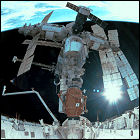 NASA launches Space Shuttle Atlantis on the 73rd shuttle flight, an eight-day mission to dock with Russian space station Mir. Due to the docking difficulties of the first flight – which required Mir crew members to move one of their station’s modules out of the shuttle’s way temporarily – Atlantis carries a Russian-made docking adapter which adds a tunnel to one of Mir’s docking ports, allowing the shuttle to join up with the station without further module relocation. Atlantis carries Commander Kenneth Cameron, Pilot James Halsell, and mission specialists Jerry Ross, William McArthur and Chris Hadfield to visit Mir; there is no crew exchange on this flight.
NASA launches Space Shuttle Atlantis on the 73rd shuttle flight, an eight-day mission to dock with Russian space station Mir. Due to the docking difficulties of the first flight – which required Mir crew members to move one of their station’s modules out of the shuttle’s way temporarily – Atlantis carries a Russian-made docking adapter which adds a tunnel to one of Mir’s docking ports, allowing the shuttle to join up with the station without further module relocation. Atlantis carries Commander Kenneth Cameron, Pilot James Halsell, and mission specialists Jerry Ross, William McArthur and Chris Hadfield to visit Mir; there is no crew exchange on this flight.
STS-71: the shuttle docks at Mir
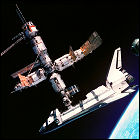 Space Shuttle Atlantis lifts off on an almost-ten-day mission to dock with the Russian space station Mir. The first docking proves to be a chore, as the Mir crew has to move one of the station’s modules to a different docking port to accomodate the shuttle. The historic docking – the first joint operation between the two countries since the Apollo-Soyuz mission almost exactly 20 years earlier – results in the largest man-made object in space to date. Aboard Atlantis are Commander Robert Gibson, Pilot Charles Precourt, and mission specialists Ellen Baker, Bonnie Dunbar and Gregory Harbaugh; cosmonauts Anatoly Solovyev and Nikolai Budarin are transported to Mir aboard Atlantis to become part of Mir Expedition 19, while Expedition 18 crew members Norman Thagard, Vladimir Dezhurov and Gannady Strekalov return to Earth after more than three months aboard Mir.
Space Shuttle Atlantis lifts off on an almost-ten-day mission to dock with the Russian space station Mir. The first docking proves to be a chore, as the Mir crew has to move one of the station’s modules to a different docking port to accomodate the shuttle. The historic docking – the first joint operation between the two countries since the Apollo-Soyuz mission almost exactly 20 years earlier – results in the largest man-made object in space to date. Aboard Atlantis are Commander Robert Gibson, Pilot Charles Precourt, and mission specialists Ellen Baker, Bonnie Dunbar and Gregory Harbaugh; cosmonauts Anatoly Solovyev and Nikolai Budarin are transported to Mir aboard Atlantis to become part of Mir Expedition 19, while Expedition 18 crew members Norman Thagard, Vladimir Dezhurov and Gannady Strekalov return to Earth after more than three months aboard Mir.
Soyuz TM-21
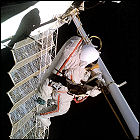 An American astronaut lifts off aboard a Russian Soyuz spacecraft for the first time ever with the launch of Soyuz TM-21, a mission to the Mir space station. Cosmonauts Vladimir Dezhurov and Gennady Strekalov are joined by astronaut Norman Thagard aboard Mir, where they remain for 115 days. During that time, they witness the arrival of the Spektr module, a new addition to the station, and they ultimately return to Earth aboard space shuttle Atlantis in July 1995; Soyuz TM-21 remains at the station, where a future Mir crew uses it to return to Earth. During the Atlantis mission, a new record is set for the number of humans in space, as the station and shuttle crews add up to 13 people in orbit at once.
An American astronaut lifts off aboard a Russian Soyuz spacecraft for the first time ever with the launch of Soyuz TM-21, a mission to the Mir space station. Cosmonauts Vladimir Dezhurov and Gennady Strekalov are joined by astronaut Norman Thagard aboard Mir, where they remain for 115 days. During that time, they witness the arrival of the Spektr module, a new addition to the station, and they ultimately return to Earth aboard space shuttle Atlantis in July 1995; Soyuz TM-21 remains at the station, where a future Mir crew uses it to return to Earth. During the Atlantis mission, a new record is set for the number of humans in space, as the station and shuttle crews add up to 13 people in orbit at once.
STS-66
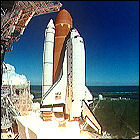 Space Shuttle Atlantis lifts off on its first flight in two years, an 11-day mission to conduct studies of Earth’s atmosphere with the ATLAS package mounted in the cargo bay. Aboard Atlantis for her 13th flight are Commander Donald McMonagle, Pilot Curtis Brown, Payload Commander Ellen Ochoa, and mission specialists Scott Parazynski, Joseph Tanner and Jean-Francois Clervoy.
Space Shuttle Atlantis lifts off on its first flight in two years, an 11-day mission to conduct studies of Earth’s atmosphere with the ATLAS package mounted in the cargo bay. Aboard Atlantis for her 13th flight are Commander Donald McMonagle, Pilot Curtis Brown, Payload Commander Ellen Ochoa, and mission specialists Scott Parazynski, Joseph Tanner and Jean-Francois Clervoy.
STS-46
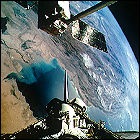 Space Shuttle Atlantis is launched on an eight-day mission to deploy two experiment packages developed jointly with the European and Italian space agencies. (The mission is extended by a day to accomodate more experiments.) Aboard Atlantis for her 12th flight are Commander Loren Shriver, Pilot Andrew Allen, mission specialists Jeffrey Hoffman, Franklin Chang-Diaz, Claude Nicollier and Marsha Ivins, and payload specialist Franco Malerba.
Space Shuttle Atlantis is launched on an eight-day mission to deploy two experiment packages developed jointly with the European and Italian space agencies. (The mission is extended by a day to accomodate more experiments.) Aboard Atlantis for her 12th flight are Commander Loren Shriver, Pilot Andrew Allen, mission specialists Jeffrey Hoffman, Franklin Chang-Diaz, Claude Nicollier and Marsha Ivins, and payload specialist Franco Malerba.
STS-45
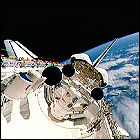 NASA launches Space Shuttle Atlantis on the 46th shuttle mission, carrying the Spacelab-based ATLAS (Atmospheric Laboratory for Applications and Science) experiment module. Aboard Atlantis for the nearly-nine-day flight are Commander Charles Bolden, Pilot Brian Duffy, Payload Commander Kathyrn Sullivan, mission specialists David Leestma and Michael Foale, and payload specialists Byron Lichtenberg and Dirk Frimout. NASA extends the mission by one day to accomodate additional experiments.
NASA launches Space Shuttle Atlantis on the 46th shuttle mission, carrying the Spacelab-based ATLAS (Atmospheric Laboratory for Applications and Science) experiment module. Aboard Atlantis for the nearly-nine-day flight are Commander Charles Bolden, Pilot Brian Duffy, Payload Commander Kathyrn Sullivan, mission specialists David Leestma and Michael Foale, and payload specialists Byron Lichtenberg and Dirk Frimout. NASA extends the mission by one day to accomodate additional experiments.
STS-44
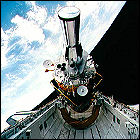 NASA launches Space Shuttle Atlantis on a mission lasting nearly a week, deploying both classified and unclassified payloads for the Defense Department. After the payload deployments, tests are conducted to determine the viability of the shuttle orbiters for long-duration missions. Manning Atlantis for this mission are Commander Frederick Gregory, Pilot Terence Henricks, and mission specialists Mario Runco, James Voss, Story Musgrave and Thomas Hennen.
NASA launches Space Shuttle Atlantis on a mission lasting nearly a week, deploying both classified and unclassified payloads for the Defense Department. After the payload deployments, tests are conducted to determine the viability of the shuttle orbiters for long-duration missions. Manning Atlantis for this mission are Commander Frederick Gregory, Pilot Terence Henricks, and mission specialists Mario Runco, James Voss, Story Musgrave and Thomas Hennen.
STS-43
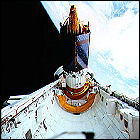 NASA launches Space Shuttle Atlantis on a satellite deployment and science mission lasting nearly nine days. The fourth TDRS (Tracking & Data Relay Satellite) is launched, and several experiments are performed on board, including materials processing experiments. Atlantis’ crew consists of Commander John Blaha, Pilot Michael Baker, and mission specialists Shannon Lucid, James Adamson and David Low.
NASA launches Space Shuttle Atlantis on a satellite deployment and science mission lasting nearly nine days. The fourth TDRS (Tracking & Data Relay Satellite) is launched, and several experiments are performed on board, including materials processing experiments. Atlantis’ crew consists of Commander John Blaha, Pilot Michael Baker, and mission specialists Shannon Lucid, James Adamson and David Low.
STS-37
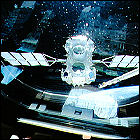 Space Shuttle Atlantis lifts off on a mission to deploy the orbiting Gamma Ray Observatory satellite. When the high-gain antenna fails to deploy on GRO, the first unplanned spacewalk since 1985 is conducted, with two of the astronauts manually releasing the antenna. Manning Atlantis for nearly six days are Commander Steven Nagel, Pilot Kenneth Cameron, and mission specialists Jerry Ross, Jay Apt and Linda Godwin.
Space Shuttle Atlantis lifts off on a mission to deploy the orbiting Gamma Ray Observatory satellite. When the high-gain antenna fails to deploy on GRO, the first unplanned spacewalk since 1985 is conducted, with two of the astronauts manually releasing the antenna. Manning Atlantis for nearly six days are Commander Steven Nagel, Pilot Kenneth Cameron, and mission specialists Jerry Ross, Jay Apt and Linda Godwin.
STS-38
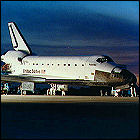 Space Shuttle Atlantis is launched on a mission involving a classified Defense Department payload, staying in Earth orbit for nearly five days. Atlantis’ crew on this flight consists of Commander Richard Covey, Pilot Frank Culbertson, and mission specialists Robert Springer, Carl Meade and Charles Gemar.
Space Shuttle Atlantis is launched on a mission involving a classified Defense Department payload, staying in Earth orbit for nearly five days. Atlantis’ crew on this flight consists of Commander Richard Covey, Pilot Frank Culbertson, and mission specialists Robert Springer, Carl Meade and Charles Gemar.